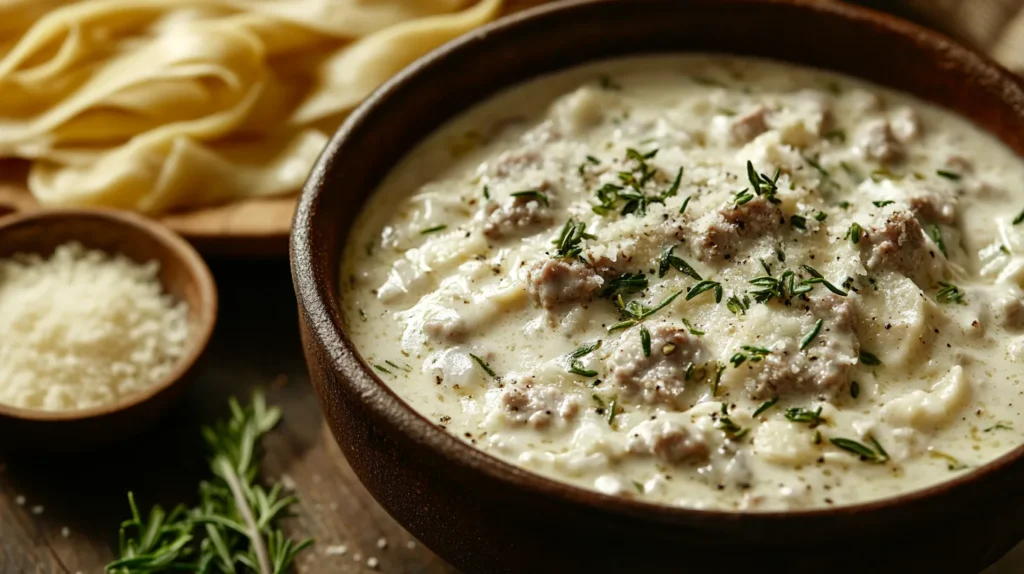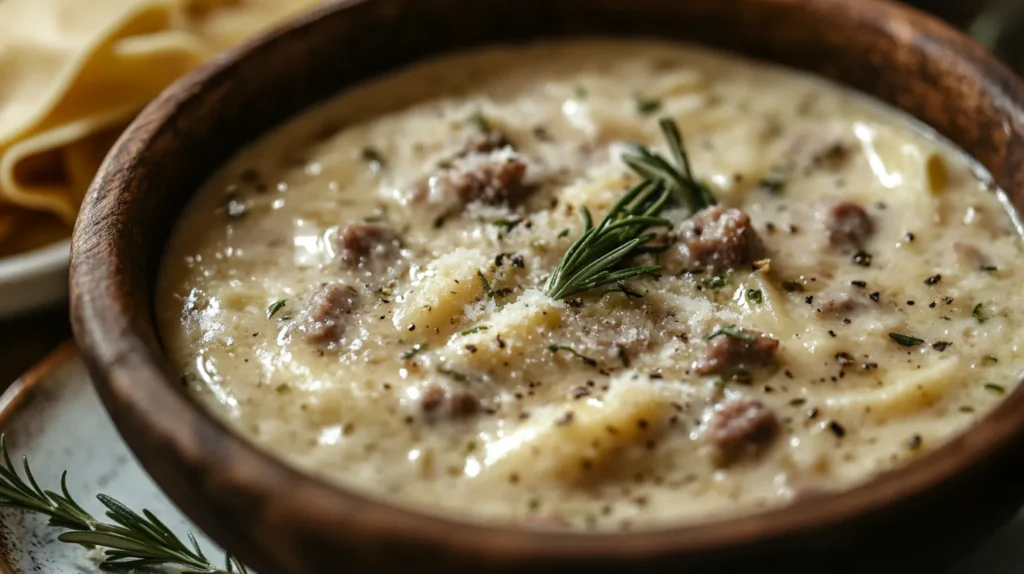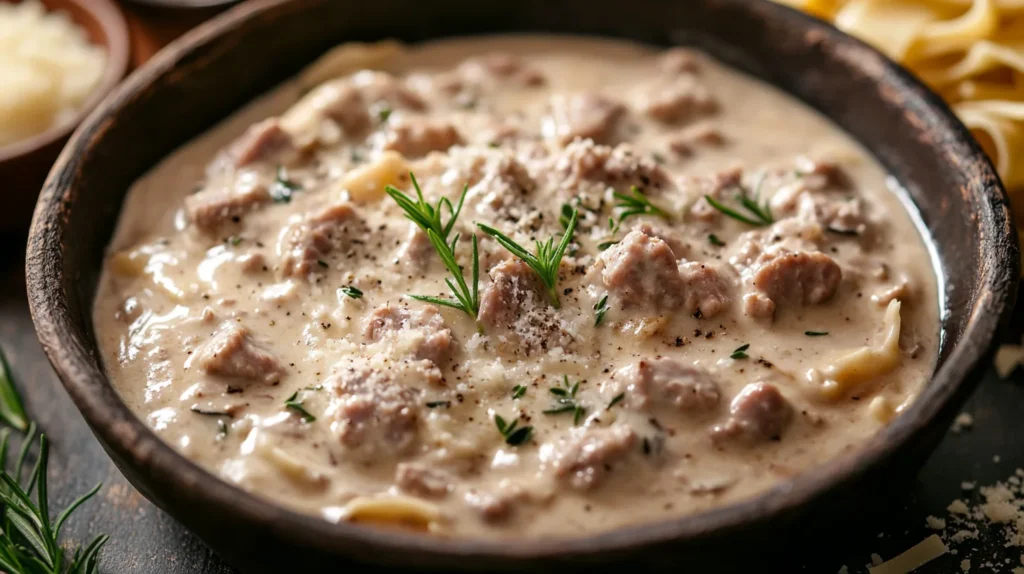What Is Norcina Sauce Made Of? – Discover the Rich Flavors and Ingredients Behind This Italian Delight
What Is Norcina Sauce Made Of? This question is often posed by food enthusiasts curious about this indulgent Italian sauce that has found its way into many kitchens worldwide. Known for its rich, creamy texture and savory flavor profile, Norcina sauce is a beloved component of various dishes, especially pasta. In this elaborate exploration, we will delve into the ingredients, cooking methods, and cultural significance of Norcina sauce, celebrating its place in Italian cuisine.
Introduction to Norcina Sauce
Norcina sauce is more than just a culinary creation; it is an embodiment of tradition, flavor, and comfort found in the heart of Italian gastronomy. Originating from the Umbria region of Italy, specifically near the town of Norcia, this sauce reflects the rustic flavors of the area, where local farmers and artisans have honed their craft for generations. The sauce showcases a blend of simplicity and richness, highlighting how certain key ingredients can transform a dish into something truly exceptional.
The Origins and Cultural Significance in Italian Cuisine
The history of Norcina sauce traces back to the 16th century when Norcia was known for its high-quality pork products. The locals took pride in their artisanal sausage-making, which became the cornerstone of many traditional recipes. Over time, the blending of creamy textures and savory flavors marked Norcina sauce as a staple in households across Italy.
In modern-day Italy, particularly in regions like Umbria and Lazio, Norcina sauce retains its status as a comfort food, often served during family gatherings and festive occasions. Each spoonful evokes warmth and nostalgia, making it an essential element of Italian culinary heritage. It not only provides sustenance but also tells a story of the land and its people, adding depth to every meal it graces.
Key Ingredients in Norcina Sauce
At the heart of Norcina sauce are several key ingredients that come together to create its unique flavor profile. These components not only provide taste but also reflect the values of Italian cooking, emphasizing quality over quantity. The primary ingredients include pork sausage, cream, and pecorino cheese, while garlic, onion, and black pepper serve as aromatic companions that elevate the sauce further.
Description of Primary Ingredients: Pork Sausage, Cream, and Pecorino Cheese
Pork sausage is the star of the show in Norcina sauce. Made from high-quality cuts of meat, this ingredient adds both depth and complexity to the dish. The sausages used can vary in style and spice levels, depending on regional preferences. This diversity means that one might encounter anything from a spicy salami to a milder sweet sausage, each imparting its unique character to the sauce.
Cream is another fundamental aspect of Norcina sauce, lending it a luscious texture and richness that makes it irresistible. It balances the robust flavors of the sausage, creating a velvety mouthfeel that coats the pasta beautifully. Depending on personal preference, cooks may choose to use heavy cream for maximum richness or opt for half-and-half for a lighter touch.
Pecorino cheese rounds out the ingredient list with its sharp, tangy taste. This sheep’s milk cheese is a hallmark of Italian cuisine, providing a distinctive flavor that complements the other ingredients. When grated and stirred into the sauce, pecorino enhances the overall depth and richness, ensuring that each bite is bursting with flavor.
Explanation of Secondary Ingredients: Garlic, Onion, and Black Pepper
While the primary ingredients form the backbone of Norcina sauce, it’s the secondary ingredients—garlic, onion, and black pepper—that add layers of aroma and seasoning. Garlic, with its pungent, slightly sweet flavor, helps to build the foundation of the sauce, infusing the oil as it cooks and releasing its complex notes.
Onion, when sautéed until translucent, contributes a natural sweetness and depth that balances the sauce’s richness. Together, these aromatics create a harmonious base that elevates the overall flavor profile.
Black pepper, with its sharp, pungent kick, acts as a finishing touch. Its freshly cracked version releases essential oils that enhance the sauce, providing a gentle heat that complements the creaminess. The interplay of these secondary ingredients is crucial in achieving a well-rounded sauce that excites the palate without overwhelming it.

Types of Pork Sausage Used
When it comes to crafting the perfect Norcina sauce, the type of pork sausage selected plays a pivotal role. With numerous varieties available, each brings its unique qualities to the table, influencing both flavor and texture. Understanding these different kinds of sausage can enhance your cooking experience and allow for greater creativity in the kitchen.
Overview of Different Varieties of Pork Sausage
In Italy, there are numerous types of pork sausage, each reflecting the characteristics of its region. Some popular options include salsiccia fresca (fresh sausage), salsiccia secca (dry sausage), and finocchiona (a fennel-flavored salami). Fresh sausages are often preferred for Norcina sauce due to their juicy and flavorful nature, which lends itself beautifully to the creamy base of the sauce.
Fresh sausage varieties typically contain a mixture of coarsely ground pork and fat, along with seasonings like salt, pepper, and herbs. The inclusion of these spices varies widely, allowing for personalized flavor profiles in the sauce. The choice of pork and herb combinations ultimately shapes the taste of the sauce, creating unique experiences with each preparation.
Discussion on Regional Variations and Their Influence on Flavor
Regional differences in Italian cuisine mean that Norcina sauce can take on distinct personalities depending on the type of sausage used. For example, in Umbria, where Norcina sauce originated, the use of local pork sausages crafted with herbs such as rosemary and fennel enhances the sauce’s authenticity. As you travel through different regions of Italy, the sausage selection often changes, offering variations in spiciness, smokiness, and even sweetness, thus transforming the sauce entirely.
Additionally, some chefs might experiment with artisanal sausages infused with local wines or unique blends of spices, resulting in flavor profiles that are not commonly found outside specific areas. Embracing these variations allows home cooks to explore the nuances of Norcina sauce, adapting the classic recipe while paying homage to its roots.
The Role of Cream in Norcina Sauce
The inclusion of cream in Norcina sauce is paramount to achieving its signature richness and smooth texture. This ingredient acts as a unifying force, bringing together the robust flavors of the pork sausage and the sharpness of the cheese. However, the type of cream used can greatly influence the final outcome of the sauce.
Importance of Cream for Texture and Richness
Cream offers a luxurious mouthfeel that elevates Norcina sauce from ordinary to extraordinary. When heated, it melds seamlessly with the other ingredients, creating a cohesive sauce that clings beautifully to pasta. The richness of the cream offsets the saltiness of the pecorino cheese while enhancing the savory notes of the sausage.
Moreover, cream serves to balance the overall flavor profile. The smooth, mellow nature of cream can soften the intensity of the sausage and pepper, ensuring that none of the flavors are overpowering. This harmony is what makes Norcina sauce so appealing to a wide audience, as it caters to varied palates without compromising on taste.
Types of Cream Commonly Used (Heavy Cream, Half-and-Half)
When preparing Norcina sauce, cooks may choose between various types of cream based on desired results. Heavy cream is a popular choice for those seeking maximum richness and density, delivering a sauce that is decadently thick and satisfying. This option is ideal for indulgent dishes meant to impress guests or for special occasions.
On the other hand, half-and-half can be used for a lighter sauce that still maintains a creamy consistency. This alternative works well for those who prefer a less calorie-dense option, allowing them to enjoy the beloved flavors of Norcina sauce without feeling weighed down. Experimenting with different types of cream opens the door to endless possibilities, enabling cooks to customize their sauces to suit individual preferences.

Pecorino Cheese: A Flavor Powerhouse
No discussion of Norcina sauce would be complete without highlighting the role of pecorino cheese—a true flavor powerhouse that transforms the sauce into something remarkable. This cheese, made from sheep’s milk, boasts a bold, salty taste that stands up to the heartiness of the sausage while enhancing the overall composition of the dish.
Explanation of Pecorino Cheese and Its Distinct Taste
Pecorino cheese possesses unique characteristics that set it apart from other cheeses. Its firm texture and sharp flavor make it an excellent grating cheese, perfect for melding into hot sauces and pastas. The flavor profile ranges from mildly nutty to intensely tangy, with aging playing a significant role in determining its taste.
Younger pecorino is sweeter and creamier, while aged variants develop a stronger, more complex flavor with crystalline textures. This complexity adds depth to the sauce, giving it an inviting umami presence that entices diners with each bite. Pecorino’s ability to harmonize with other ingredients while still asserting itself is what makes it a vital component in Norcina sauce.
How It Enhances the Overall Profile of the Sauce
Integrating pecorino cheese into Norcina sauce is akin to adding a finishing touch to a masterpiece. As the cheese melts into the bubbling sauce, it creates a rich, creamy layer that envelops the pork sausage. This integration enhances the overall flavor, offering a delightful contrast to the creaminess of the sauce and the spiciness of the sausage.
The sharpness of pecorino cheese can cut through the richness, creating a balanced flavor palette that invites the diner to savor each bite. Additionally, the cheese’s saltiness amplifies the savory elements present in the sauce, making it more gratifying overall. Whether served atop freshly cooked pasta or used as a dip, pecorino cheese completes the Norcina sauce experience, leaving a lasting impression on anyone fortunate enough to indulge in this delectable dish.
Aromatics and Seasoning
Aromatic ingredients play a crucial role in building the flavor foundation of Norcina sauce. The careful use of garlic, onion, and black pepper not only enhances the sauce but also elevates its overall sensory experience. By understanding how these components work together, cooks can create a sauce that tantalizes the taste buds and leaves a lasting impact.
The Use of Garlic and Onion in Building Flavor
Garlic and onion are beloved staples in Italian cuisine, renowned for their ability to bring depth and character to dishes. In Norcina sauce, these aromatics are the first ingredients to hit the pan, releasing their fragrant oils as they sauté in olive oil.
Garlic imparts a warm, earthy flavor that builds complexity in the sauce. Its aromatic qualities awaken the other ingredients, allowing their flavors to shine through. Onion, meanwhile, provides a subtle sweetness that contrasts beautifully with the robustness of the sausage and cheese. Together, these ingredients create a layered foundation that ensures each bite is rich and full-bodied.
Importance of Fresh Black Pepper for Seasoning
Black pepper, often considered a humble seasoning, plays a vital role in elevating Norcina sauce. The careful addition of freshly cracked black pepper introduces a gentle heat that balances the creaminess of the sauce. Unlike pre-ground pepper, fresh black pepper retains its essential oils, providing a more vibrant and nuanced flavor.
Incorporating black pepper in the right amounts allows for customization based on personal preferences. Some may enjoy a milder heat, while others may crave a spicier kick. This flexibility encourages experimentation and fosters a connection between the cook and the dish, making it feel truly individualized. The right amount of black pepper can transform the overall experience, creating a sauce that is not only delicious but memorable.
Cooking Method for Norcina Sauce
Making Norcina sauce is a straightforward process that allows even novice cooks to create a dish bursting with flavor. By following a few simple steps, anyone can master this beloved Italian sauce and impress friends and family alike.
Step-by-step Process of Making Norcina Sauce
To begin making Norcina sauce, gather all necessary ingredients: pork sausage, cream, pecorino cheese, garlic, onion, and black pepper. Start by heating a large skillet over medium heat and adding olive oil. Once the oil is shimmering, add chopped onions and minced garlic, sautéing until they become translucent and fragrant.
Next, crumble the pork sausage into the skillet, allowing it to brown thoroughly. This step is crucial for developing a deep, savory base. As the sausage cooks, the natural fats will release, creating flavorful drippings that enhance the sauce. Once the sausage is fully cooked, reduce the heat to low and pour in the cream, stirring to integrate the ingredients.
Finally, grate in the pecorino cheese and allow it to melt, stirring continuously to achieve a smooth consistency. Season with freshly cracked black pepper to taste, adjusting according to your preference. Allow the sauce to simmer gently for a few minutes to let the flavors meld and deepen.
Tips for Achieving the Perfect Consistency
Achieving the perfect consistency for Norcina sauce requires attention to detail. One tip is to control the heat; too high of a flame may cause the cream to curdle, while too low might result in a watery sauce. A moderate heat allows the sauce to thicken naturally while retaining its creamy texture.
If the sauce appears too thick, consider adding a splash of pasta water or broth to thin it out. Conversely, if it seems too runny, a longer simmering time should help concentrate the flavors and encourage thickening.
Lastly, always taste the sauce before serving! Adjust seasonings as needed and ensure it meets your personal preferences. The final product should be a luscious, creamy sauce that clings to your choice of pasta, creating a comforting and satisfying dish.

Common Dishes That Use Norcina Sauce
Norcina sauce isn’t limited to pasta; its versatility allows it to complement various dishes, making it a cherished component of Italian cuisine. Understanding its potential applications can inspire creativity in the kitchen and lead to delightful culinary discoveries.
Popular Pasta Dishes Featuring Norcina Sauce
The most common pairing for Norcina sauce is pasta. Tagliatelle, fettuccine, or pappardelle are particularly well-suited for this hearty sauce, as their broad surfaces capture every luscious drop. Tossing freshly cooked pasta with Norcina sauce creates an inviting dish that is both comforting and indulgent.
Adding seasonal vegetables, such as peas or mushrooms, can enhance the dish further, introducing additional textures and flavors that marry beautifully with the creaminess of the sauce. Topping the finished dish with extra pecorino cheese and freshly cracked black pepper takes it over the top, creating a restaurant-quality experience at home.
Other Potential Uses in Appetizers and Main Courses
Beyond pasta, Norcina sauce can serve as an enticing component in appetizers and main courses. For instance, it can be drizzled over roasted vegetables or used as a dipping sauce for crusty bread, allowing diners to indulge in its rich flavors.
Additionally, Norcina sauce can elevate main courses like chicken or fish. Pan-searing proteins and finishing them with a generous spoonful of the sauce creates a luxurious dining experience. The sauce’s creaminess and savory depth meld beautifully with the protein, enriching the overall dish.
Creative cooks might even incorporate Norcina sauce into risotto or pizza, expanding its culinary horizons beyond traditional uses. The possibilities are endless, limited only by one’s imagination.
Variations of Norcina Sauce
While the traditional recipe for Norcina sauce is beloved, there is ample room for personalization and adaptation. Exploring variations allows cooks to infuse their unique touch into this classic dish, ensuring that it remains relevant and exciting.
Alternative Ingredients or Methods for Personalization
For those wishing to experiment with flavor profiles, there are countless ways to personalize Norcina sauce. Using different types of meat, such as chicken or turkey sausage, can create a lighter version without sacrificing taste. Similarly, smoked sausage adds a new dimension of flavor that can be captivating and delicious.
Incorporating fresh herbs, like parsley or basil, can brighten the dish and introduce a refreshing element that complements the richness. Additionally, substituting cream with alternatives like coconut cream or cashew cream can cater to dietary needs while maintaining a pleasing texture.
Vegetarian or Vegan Adaptations of Norcina Sauce
For those seeking vegetarian or vegan interpretations of Norcina sauce, innovative adaptations can deliver satisfying results. Plant-based sausages, available in a range of flavors and textures, can replace traditional pork sausage beautifully.
To replicate the creaminess of the original sauce, nut-based creams or silken tofu blended with nutritional yeast can create a rich, dairy-free alternative. Introducing mushrooms, such as cremini or shiitake, can provide umami depth, mimicking the savory flavor profile of the classic dish.
These adaptations not only make Norcina sauce inclusive but also showcase the versatility of ingredients in modern cooking. By embracing change, cooks can continue to enjoy the essence of Norcina sauce while catering to diverse dietary preferences.
Nutritional Information
As with any rich and creamy sauce, understanding the nutritional content of Norcina sauce is important for those mindful of their dietary choices. While this sauce is undeniably delicious, being aware of its nutritional aspects can help with moderation and meal planning.
Overview of Nutritional Values Associated with Norcina Sauce
Typically, Norcina sauce contains higher levels of calories, fat, and sodium due to its creamy nature and the inclusion of pork sausage. A standard serving can offer a rich source of protein, thanks to the sausage and cheese, while the cream contributes dietary fat.
However, the nutritional values can fluctuate significantly based on ingredient choices. Opting for leaner sausage or reducing the cream can create a lighter and healthier version of the sauce without compromising on flavor.
Considerations for Dietary Restrictions
Given the sauce’s reliance on dairy and meat, it may not align with certain dietary restrictions, including lactose intolerance, vegetarianism, or veganism. Cooks must remain mindful of these considerations when preparing Norcina sauce for guests with specific dietary needs.
By employing creative substitutions and alternatives, it is possible to retain the essence of Norcina sauce while accommodating various restrictions. Offering alternatives alongside the traditional sauce ensures that everyone can experience the joy of this Italian delight.
Frequently Asked Questions
What is nduja sauce made of?
Nduja is a spicy, spreadable sausage from Calabria, Italy. It combines pork, chili peppers, and spices to create a bold flavor. You can use it as a condiment or, alternatively, mix it into pasta sauces to add a fiery kick. Furthermore, its versatility allows it to be incorporated into a variety of dishes, enhancing their depth with its spicy richness. Whether you spread it on bread or stir it into stews, Nduja brings a unique Italian flair to your cooking.
What is Norcina?
Norcina refers to dishes originating from Norcia, Italy, especially those made with pork products. The most famous dish features Norcina sauce, made with sausage, cream, and truffles.
What is the most popular spaghetti sauce in Italy?
In Italy, pomodoro is the most popular spaghetti sauce. It’s a simple, yet flavorful sauce made with tomatoes, garlic, olive oil, and basil. Additionally, other favorite sauces include Bolognese and Aglio e Olio. While pomodoro is light and fresh, Bolognese offers a rich, hearty flavor, often made with ground beef and slow-cooked vegetables. On the other hand, Aglio e Olio provides a simpler, garlicky option, perfect for those who prefer a more minimalistic approach. Therefore, these sauces showcase the wide range of flavors that Italian cuisine has to offer.
What is Norcina in English?
“Norcina” refers to the culinary traditions of Norcia, Italy, especially pork-based dishes. In English, people often use it to describe the rich, creamy sauce made with pork, cream, and truffles.
Conclusion
In conclusion, Norcina sauce is a testament to the art of Italian cooking, combining robust flavors and creamy textures to create a dish that warms the heart and satisfies the palate. Understanding the key ingredients—pork sausage, cream, and pecorino cheese—along with the importance of aromatics and seasoning, enables cooks to master this beloved sauce and explore its myriad applications.
Whether tossed with pasta, drizzled over roasted vegetables, or served as a dip, Norcina sauce has earned its place in kitchens around the world. Through variations and personalized adaptations, this timeless sauce continues to evolve, proving that tradition and innovation can go hand in hand. So, what is Norcina sauce made of? It’s not just a collection of ingredients; it’s a celebration of culture, flavor, and the love of good food.
For more delicious ideas, check out our Easy Potluck Dishes and Tequeños Recipe for perfect pairings with Norcina sauce. Additionally, learn about the history of truffles here.
Print
What Is Norcina Sauce Made Of? – Discover the Rich Flavors and Ingredients Behind This Italian Delight
- Total Time: 30 minutes
- Yield: 4 servings
Description
Norcina Sauce is a classic Italian sauce hailing from the Umbria region. This delicious dish combines savory sausage with creamy flavors, typically featuring a base of cream, mushrooms, and a touch of white wine. Perfect over pasta or served with vegetables, it brings comfort and warmth to any meal.
Ingredients
- Italian sausage (bulk, not in casings): 1 lb
- Olive oil: 2 tbsp
- Garlic (minced): 2 cloves
- Mushrooms (sliced): 2 cups
- Heavy cream: 1 cup
- White wine: ¼ cup
- Chicken broth: ½ cup
- Fresh thyme: 1 tsp
- Salt: To taste
- Black pepper: To taste
- Fresh Parmesan cheese (grated): ¼ cup
- Fresh parsley (chopped, optional): For garnish
Instructions
-
Cook the Sausage:
- In a large skillet, heat the olive oil over medium heat.
- Add the sausage and cook, breaking it apart with a spoon until browned and cooked through (about 7-10 minutes).
-
Sauté Garlic and Mushrooms:
- Add the garlic and sliced mushrooms to the skillet.
- Cook for 5-7 minutes, until the mushrooms are tender and the garlic is fragrant.
-
Deglaze and Simmer:
- Pour in the white wine, scraping up any browned bits from the bottom of the pan.
- Add the chicken broth and thyme, then bring to a simmer for about 5 minutes to allow the sauce to reduce slightly.
-
Add Cream and Simmer:
- Stir in the heavy cream, and season with salt and pepper to taste.
- Let the sauce simmer for another 5 minutes, thickening slightly.
-
Finish and Serve:
- Stir in the grated Parmesan cheese, allowing it to melt into the sauce.
- Serve the Norcina Sauce over your favorite pasta, garnished with fresh parsley if desired.
Notes
- For extra richness, you can add a touch of mascarpone cheese or cream cheese along with the heavy cream.
- If you like a spicier sauce, opt for spicy Italian sausage instead of mild.
- Great Pairing: This sauce goes wonderfully with pappardelle, fettuccine, or rigatoni.
- Prep Time: 10 minutes
- Cook Time: 20 minutes
- Category: Sauce
- Method: Sautéing/Simmering
- Cuisine: Italian
Nutrition
- Serving Size: 1 cup
- Calories: 350
- Sugar: 3g
- Sodium: 560mg
- Fat: 30g
- Saturated Fat: 11g
- Unsaturated Fat: 17g
- Trans Fat: 0g
- Carbohydrates: 6g
- Fiber: 1g
- Protein: 20g
- Cholesterol: 70mg
Keywords: Norcina sauce, Italian sausage sauce, creamy pasta sauce, mushroom cream sauce, Umbria sauce recipe

